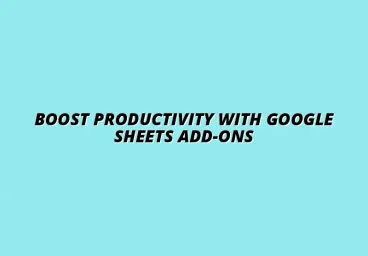Track Personal Finance with Google Sheets

Understanding Personal Finance Tracking with Google Sheets
Keeping track of personal finances can seem overwhelming at first. With so many expenses, incomes, and bills to manage, having a clear system is crucial. That’s where personal finance tracking comes into play, allowing individuals to understand and control their financial situation more effectively.
Using tools like Google Sheets can simplify this process. It provides a flexible platform for organizing finances, helping you see where your money goes and where you can save. By tracking your income and expenses, you can make informed decisions about your spending habits and savings goals. To effectively manage your financial data, consider learning how to organize financial data in Google Sheets.
Importance of Personal Finance Management
Managing personal finances is essential for achieving financial stability and independence. By keeping an eye on your spending, you can identify patterns and areas where you might be overspending. This awareness is critical for setting and reaching financial goals, whether it’s saving for a trip, paying off debt, or planning for retirement.
Moreover, effective personal finance management can help reduce stress. Knowing exactly where your money is going can relieve anxiety about unexpected costs or not being able to pay bills. In the long run, it sets you up for a more secure financial future and gives you the confidence to make smarter financial choices.
- Helps in achieving financial goals
- Reduces stress related to money management
- Promotes better spending habits
Why Google Sheets is an Effective Tool for Budgeting
Google Sheets offers a user-friendly interface combined with powerful features that make it ideal for budgeting. First, it is free and accessible from anywhere, making it easy to update your finances on the go. This accessibility means you can track your spending in real-time, which is a game-changer for maintaining an accurate budget.
Another reason why many choose Google Sheets is the ability to customize spreadsheets to meet individual needs. You can create specific categories for income and expenses, use formulas for calculations, and even visualize your data through charts. This level of customization allows for a tailored approach to budgeting that can adapt as your financial situation changes. Learn more about creating a personal finance workflow in Google Sheets to maximize its potential.
- Free and accessible from any device
- Highly customizable for personal needs
- Built-in formulas and functions for easy calculations
Essential Google Sheets Features for Personal Finance Tracking
When it comes to personal finance tracking, leveraging Google Sheets can significantly enhance your ability to manage your money. The platform is packed with features that can simplify your budgeting process. From templates to formulas, knowing what tools are at your disposal can make all the difference. Mastering essential functions is key; explore these essential Google Sheets functions for finance.
One fantastic feature is the availability of templates specifically designed for personal finance. These templates can save you time and effort, enabling you to set up your budget quickly. In addition, using formulas can automate calculations, reducing the chances of human error and making tracking your finances a breeze.
Utilizing Templates for Quick Setup
Templates are a great way to kickstart your personal finance tracking. They offer a structured layout that you can fill in with your financial information. This allows you to focus on your spending and saving habits rather than getting bogged down with the formatting and setup of a new spreadsheet.
- Pre-designed layouts for easy data entry
- Quickly adapt to personal finance needs
- Save time on formatting and calculations
Finding the Best Personal Finance Templates
There are numerous places online where you can find quality personal finance templates. Google Sheets itself offers many free templates that can be accessed directly from its template gallery. Additionally, websites like Template.net or Vertex42.com provide a variety of options tailored for different budgeting needs.
When choosing a template, it's essential to consider what features you need. Do you want something simple, or do you need a more complex setup with multiple accounts and categories? Take your time to explore different templates until you find one that suits your financial tracking style.
Customizing Templates to Fit Individual Needs
Once you’ve chosen a template, you can easily customize it to better fit your needs. Adding or removing categories, changing colors, or adjusting columns can help ensure that your spreadsheet reflects your unique financial situation. Personalizing your template can make it more user-friendly, encouraging you to use it regularly.
- Modify categories to reflect your spending habits
- Adjust formulas for accurate calculations
- Change formatting for better readability
Leveraging Formulas for Efficient Calculations
Formulas in Google Sheets are powerful tools that can simplify financial calculations. They can help you automatically sum expenses, calculate averages, and even project future savings. Knowing how to use these formulas can save you time and make your financial tracking more efficient. Discover tips and tricks for Google Sheets automation to boost your productivity.
One of the most common formulas used for budgeting is the SUM function, which allows you to total your expenses easily. Other useful formulas include AVERAGE for finding average spending and IF statements for conditional calculations. These can all contribute to a more dynamic budgeting experience.
- SUM: To total expenses
- AVERAGE: To find typical spending
- IF: For conditional calculations
Commonly Used Formulas for Budgeting
In personal finance tracking, there are several formulas that can significantly enhance your budgeting experience. The SUMIF formula can calculate totals based on specific criteria, such as only summing expenses in a particular category. The COUNTIF formula can help track how many times you've spent on a certain expense, like dining out.
Additionally, you can use the PMT formula to calculate loan payments, which is quite useful for budgeting for debts. Understanding these formulas can give you a clearer picture of your financial health, allowing for better decision-making. Managing large datasets efficiently is crucial; here's how to manage large datasets in Google Sheets.
How to Create Automated Calculations for Expense Tracking
Automating calculations is a great way to streamline your expense tracking. By setting up formulas that reference specific cells, you can manage ongoing expenses without manually updating each time. For example, if you have a cell that tracks your total income, you can create a formula to automatically subtract your expenses and show your net income. Learn how to automate your finances with Google Sheets for increased efficiency.
Additionally, using functions like TODAY() can help track your spending over specific time periods by filtering data. This way, you can see trends over weeks or months without repeated manual entry. Automation not only saves time but also helps in maintaining accuracy. Data cleaning is essential for accurate analysis; learn how to clean data in Google Sheets for better results.
Reflecting on Your Financial Progress
Taking time to reflect on your financial progress is essential for making informed decisions. A monthly review allows you to see how well you’re sticking to your budget and highlights areas where you can improve. By setting aside a dedicated time each month, you can assess your spending habits and make adjustments as needed!
During your review, consider assessing the following aspects:
- Comparison of actual spending vs. budgeted amounts
- Identifying any unexpected expenses
- Reviewing your savings progress towards financial goals
Strategies for Monthly Reviews of Your Budget
Establishing a consistent strategy for monthly reviews can significantly enhance your financial awareness. Start with gathering all your financial statements and reviewing your Google Sheets tracker. This will give you a clear view of your income, expenses, and savings!
Here are a few strategies to ensure your monthly reviews are effective:
- Set a specific day each month to conduct your review
- Compare your monthly results with previous months
- Adjust your budget based on your findings
Identifying Areas for Improvement in Financial Habits
Recognizing areas where you can improve your financial habits is a key component of personal finance management. After your monthly review, take a moment to reflect on your spending patterns and identify any unhealthy habits. This step is crucial for making sustainable changes!
Common areas for improvement may include:
- Reducing impulse purchases
- Finding ways to cut down on subscriptions or recurring expenses
- Increasing contributions to savings or emergency funds
Encouragement to Take Action on Personal Finance Management
Now that you understand the importance of tracking your finances, it’s time to take actionable steps! Implementing a Google Sheets tracker can be a game-changer in how you manage your money. Setting this up may seem daunting at first, but I'm here to help guide you through the process!
Taking these steps will help you create a solid foundation for managing your finances. Here are some practical next steps:
- Create a new Google Sheets document for your tracker
- Set up income and expense categories
- Start inputting your data regularly
Next Steps for Setting Up Your Google Sheets Tracker
To set up your Google Sheets tracker, follow these sequential steps. It can be as simple or as detailed as you wish, depending on your personal goals. Don't hesitate to make adjustments as you learn more about your financial habits!
- Open Google Sheets and create a new spreadsheet.
- Establish categories for income and expenses.
- Input your current income and expenses.
- Set up formulas to automate calculations.
- Review and adjust this tracking tool monthly.
Resources for Further Learning About Personal Finance
Don't stop here! There are many resources available to help you deepen your understanding of personal finance. From books to online courses, you can find valuable information to guide you on your journey. Here are some resources to consider:
- Personal finance blogs for tips and advice
- Books on budgeting and financial management
- Online courses focusing on personal finance tools
Final Thoughts on Utilizing Google Sheets for Personal Finance Tracking
As we wrap up, it’s clear that using Google Sheets for personal finance tracking is an effective strategy. With its flexibility and range of features, this tool can simplify your budgeting process and help you stay on track. Remember, the goal isn’t perfection but progress!
Here’s a quick recap of key tips and best practices:
- Regularly review and adjust your budget
- Utilize templates and formulas for efficiency
- Take advantage of visualizations to track spending trends
Recap of Key Tips and Best Practices
In summary, actively engaging with your finances through Google Sheets can lead to better financial decision-making. With consistent tracking and monthly reviews, you'll gain insights into your spending habits. So, keep refining your approach to financial management, and watch your confidence grow!
Lastly, I encourage you to share your experiences with others! By sharing insights and lessons learned, you not only help yourself but also empower those around you to take control of their financial futures. After all, personal finance is a journey we can all benefit from discussing and exploring together!
Popular Posts
 Understanding the Importance of Shortcuts in Google Sheets for Power Users
When it comes to working
Understanding the Importance of Shortcuts in Google Sheets for Power Users
When it comes to working
 Understanding Google Sheets and Its Importance
Google Sheets is a powerful, web-based spreadsheet ap
Understanding Google Sheets and Its Importance
Google Sheets is a powerful, web-based spreadsheet ap
 Understanding Shortcuts in Google Sheets
When it comes to working efficiently with Google Sheets, kn
Understanding Shortcuts in Google Sheets
When it comes to working efficiently with Google Sheets, kn
 Understanding the Value of Add-ons in Google Sheets for Enhanced Productivity
Google Sheets is a pow
Understanding the Value of Add-ons in Google Sheets for Enhanced Productivity
Google Sheets is a pow
